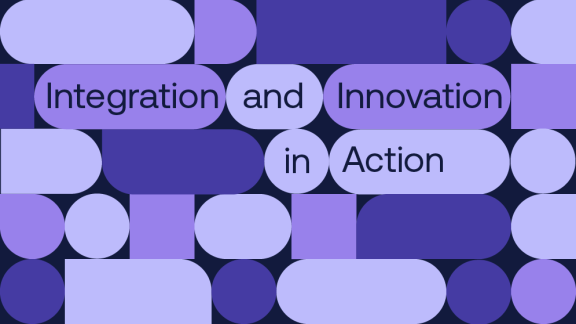Key points
- While the COVID-19 pandemic has laid bare and exacerbated underlying social and economic inequalities, it has also shown how collaborations between statutory and community-led organisations can support those in need through social networks.
- Health and care systems are connecting people, place and power structures to establish partnerships that are sharing power and decision-making – creating healthier, resilient and empowered communities.
- This report spotlights some of these examples, demonstrating how health and care organisations are working in new and different ways to improve population health. It also distils a set of critical enablers.
- For those areas making notable progress, collaborative action – where communities and system partners work together to improve health outcomes – has been a vital enabler. System leadership and a strategic focus on prevention, integration and equity also feature highly.
- Integrated data and evaluation are fundamental to measuring the impact of population health improvement initiatives and to ensure interventions are data driven and evidence based.
- Integrated care systems provide an opportunity to unite behind a shared population health framework that focuses on outcomes and needs based resource allocation.
- Local health and care systems need to reset their focus to cultivate the conditions for health creation through asset-based community health development.

Background
While efforts to tackle health inequalities were underway before the onset of COVID-19, it took the effects of a global pandemic to propel a renewed focus on the issue. The NHS planning guidance for 2022/23, released late last year, asked systems to prioritise health equity for underserved communities through prevention programmes, ramping up population health management capability and making best use of resources to strengthen local communities. It builds on other prescriptions for addressing inequalities rolled out as the effects of the pandemic were laid bare.
It is due to be followed by a white paper on health disparities in England, expected this summer. The paper will set out a strategy to tackle the core drivers of inequalities in health outcomes, with a strong focus on prevention and disparities by ethnicity, socio-economic background and geography.
Amid the central prescriptions, a growing number of health and care organisations are working in new and different ways to make positive strides in this area. For those making notable progress, collaborative action – where communities and system partners work together to improve health outcomes – has been a critical enabler.
This and other critical enablers are the focus of this report, which shines a light on how health and care systems are collaborating with partners to create health within local communities. In many of the examples, partnerrs are working in new ways to allocate resources based on need, with co-production and co-delivery firmly rooted in their operating models – an approach we would like to see advocated in the white paper.
Based on interviews with leaders in local systems, the report draws on case studies that demonstrate a range of different approaches at system, place and neighbourhood level. Some health systems are tackling inequalities through integrated datasets and population health management (such as Lewisham and Greenwich NHS Trust), while others are using the prism of disease risk factors, such as smoking (South Yorkshire and Bassetlaw Integrated Care System). Others are employing different community-centred health creation responses focusing on community assets, resilience and empowerment (such as Forward-Thinking Birmingham and Growing Health Together Horley).
The report is the latest in our Integration and Innovation in Action series. We are grateful to the leaders who have given their time to contribute to this publication. Our hope is that the insights will support your ambitions to improve population health, shine a light on the changing way our members are working, and connect you with a community of leaders across the health and care sector.
This edition draws on the following case studies:
- Lewisham and Greenwich NHS Trust, which has developed a population health and care platform to identify and target underserved populations using an integrated data set
- South Yorkshire and Bassetlaw Integrated Care System, whose innovative smoking cessation programme in hospitals makes managing tobacco addiction part of its routine care offer
- Forward Thinking Birmingham, a collaborative system working to support early parent-infant relationships across the Birmingham and Solihull Integrated Care System.
- Growing Health Together (Horley), which is connecting individuals and organisations to improve the conditions for place-based health to flourish through a co-creation approach to health and wellbeing.
Chapter footnotes
- 1. The Health Creation Alliance. https://thehealthcreationalliance.org/health-creation/ ↑
Creating healthy populations: the enablers
System leadership
“Improving population health outcomes takes time, effort, resource and senior leadership to deliver.”
If there was one resounding message from our interviews it was that addressing systemic health inequalities and poorer outcomes in deprived communities starts with adopting a systems perspective – leveraging senior leadership across the full range of organisations that are involved in and/or affect health and care. Integrated care systems present a golden opportunity in this respect.
South Yorkshire and Bassetlaw Integrated Care System’s QUIT programme is a prime example. The innovative hospital-based smoking cessation programme is transforming the way smoking is tackled by the NHS in the region.
Delivered in partnership across five local authorities and four acute trusts – covering a population of 1.5 million – the programme has benefited from senior multi-directorate managerial and clinical support across the system, including Yorkshire Cancer Research. A consistent system-wide methodology has supported the cultural shift needed to treat tobacco addiction differently – not as a lifestyle choice but as a disease.
By making the treatment of tobacco addiction part of routine care, the programme has the potential to save up to 2,000 lives and avoid 4,000 hospital readmissions a year.
The decision to adopt the approach was taken based on evidence from successful schemes elsewhere boasting not only enhanced smoking cessation rates but wider benefits, such as reduction in the life expectancy gap between the most deprived and the most affluent communities. More than 200 NHS staff have become ‘QUIT Champions’ as part of their role to help hospital patients and staff give up smoking. [ 2 ]
Taking the long view
The leaders we interviewed voiced a passionate desire to tackle health inequalities in their area. But to really make a difference, all raised the need for long-term reform and strategic and sustained action.
For Lewisham and Greenwich NHS Trust, taking the long view has been a critical enabler of progress. In 2017, the south-east London trust developed a long-term population health programme. Having recognised the crucial role of data integration across its system, the board committed investment in the HealthIntent tool. The tool is a near real-time integrated dataset that allows users to delve into patient population insights from data sourced from primary care, secondary care, community care and mental health.
A number of projects are using the tool to better manage and identify people with long term-conditions, to intervene early, reduce the risk of deterioration and decrease unnecessary use of healthcare services. This includes projects on diabetes, COVID-19, waiting lists and perinatal mental health.
The development of this data set would not have been possible without the strategic foresight to invest in a preventative and equitable approach to health improvement
The tool has enabled the early identification of patients at risk of developing diabetes, and, through its risk stratification functionality, has enabled the trust to identify and prioritise areas and populations of focus for the COVID-19 vaccine programme.
The development of this data set would not have been possible without the strategic foresight to invest in a preventative and equitable approach to health improvement, and the long-term commitment to the project.
It meant that the trust was well-placed to understand their population and tailor care accordingly when the pandemic struck. The integrated dataset was seen as the start to the journey of targeting health and care interventions based on need of the local population. As the tools mature, the benefits of preventing ill health and early intervention will grow and translate into demonstrable impact of reducing health inequalities.
“It’s nice to have these dashboards and realise there is lots of potential, but it’s what happens next that’s key.”
Data, measurement and evaluation
Good data, performance management and monitoring are vital to the success and impact of local action to reduce health inequalities and improve population health. Lewisham and Greenwich NHS Trust’s integrated data set, for example, enables quantitative analysis and early identification of pre-diabetes patients and helped to flag areas of poor COVID-19 vaccination uptake. The insights are leading to earlier interventions, reducing the risk of patient deterioration and decreasing unnecessary use of healthcare services.
Similarly, South Yorkshire and Bassetlaw QUIT programme allows analysis of quitters by demographics, such as age, ethnicity, socio-economic status. This enables the programme to target support where it is most required, but also to measure the relative impacts on different communities.
In Horley the local community is seen as a co-producer of health rather than consumers of services
For some programmes it takes a little longer to identify, collect and analyse the right data. Growing Health Together in Horley, for example, is a collaboration between local communities and local providers. While it is at an early stage of maturity and therefore lacking quantitative data of impact, it has started to map the quantitative and qualitative insights it will use to assess the impact of its work to improve access to conditions for health and wellbeing in the area. Here, the local community is seen as a co-producer of health rather than consumers of services.
There will, however, always be some impact that will evade quantification. Several leaders spoke of the considerable time and resource spent carrying out activities that helped strengthen local systems to focus on improving population health. Actions such as creating collaborative spaces and forums, or fostering cross-sector relationships to enhance vertical and horizontal integration, were viewed as the building blocks for system working, but which are not easily be measured or evaluated.
Engaging with communities: collaborative action
For the leaders we interviewed, the disproportionate impact of the pandemic was a stark reminder that current health, economic and social contexts are not good for many individuals and communities, and that change is needed. The collision of social and biological interactions caused by the pandemic served to highlight the importance of the non-health actors and communities that shape wellbeing and life chances.
Health and care systems are not built on contracts, but on connecting with communities through a shared vision
The Growing Health Together in Horley programme, founded by a group of general practitioners, is collaborating with local partners and people to develop an appropriate response that recognises community activities, assets and aspirations as keys to a wider response for improving health and wellbeing. Initiatives within Horley included primary care network collaboration with:
- the borough council regarding a green social prescribing project beside the River Mole
- engagement with local citizens who run fitness classes
- exploring ways of increasing awareness of what is available
- making activities more accessible for all.
System leaders spoke highly of this way of engaging with communities and creating health within systems, describing it as a major mechanism for building resilience within individuals and communities. This is important, they felt, as health and care systems are not built on contracts, but on connecting with communities through a shared vision. While the health creation approach is not new, it requires widespread adoption. This could be facilitated by cross-sector collaboration and place-based working.
Forward Thinking Birmingham, a unique community and inpatient mental health partnership, exemplifies this. It is building relationships across partners, including communities, to create a collaborative system within Birmingham and Solihull ICS to support early parent-infant relationships. By taking a systems approach, the partnership is improving the emotional and social support for children, parents and families.
Communities know what they need and by listening, professionals can work with them to respond and create the right conditions and social networks for improving population health outcomes.
As these examples show, health systems and service providers are connecting people, place and power structures to establish partnerships that share power and decision-making – creating healthier, resilient and empowered communities.
“Listen to what works and what has not worked, as health creation works best when people and professionals work together as equal partners.”
Chapter footnotes
- 2. South Yorkshire and Bassetlaw ICS. QUIT stop smoking programme appoints more than 200 NHS ‘champions’. https://sybics.co.uk/news/latest/partners-news-quit-stop-smoking-programme-appoints-more-200-nhs-champions?newsID= ↑
What we’ve learned
- How we think about population health and health systems needs to reflect the realities of individuals and the communities in which they are born, live, work and die. Population health patterns and inequities are never inevitabilities, but rather the reflection of local and national political actions and power imbalances.
- Equitable population health improvement requires system leaders that prioritise prevention, integration and equity, using data and evidence-based interventions. Placing people and community assets at the centre of reducing health inequalities is mission critical.
- Long-term reform and strategic and sustained action is needed to shift the dial, supported by governance structures that allow service and finance resource allocation to be based on need and outcomes.


